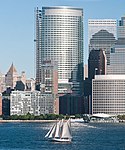111 Murray Street
Condominiums and housing cooperatives in ManhattanFinancial District, ManhattanKohn Pedersen Fox buildingsPencil towers in New York CityResidential buildings completed in 2018 ... and 4 more
Residential skyscrapers in ManhattanTribecaUse mdy dates from August 2019West Side Highway

111 Murray Street (formerly known as 101 Murray Street or 101 Tribeca) is a residential skyscraper completed in 2018 in Manhattan, New York City. Developed by Witkoff Group and Fisher Brothers, the building is located at the intersection of Murray and West Streets, in the Financial District and Tribeca neighborhoods and close to Battery Park City.
Excerpt from the Wikipedia article 111 Murray Street (License: CC BY-SA 3.0, Authors, Images).111 Murray Street
Murray Street, New York Manhattan
Geographical coordinates (GPS) Address External links Nearby Places Show on map
Geographical coordinates (GPS)
| Latitude | Longitude |
|---|---|
| N 40.7155556 ° | E -74.0127778 ° |
Address
Murray Street 111
10282 New York, Manhattan
New York, United States
Open on Google Maps







